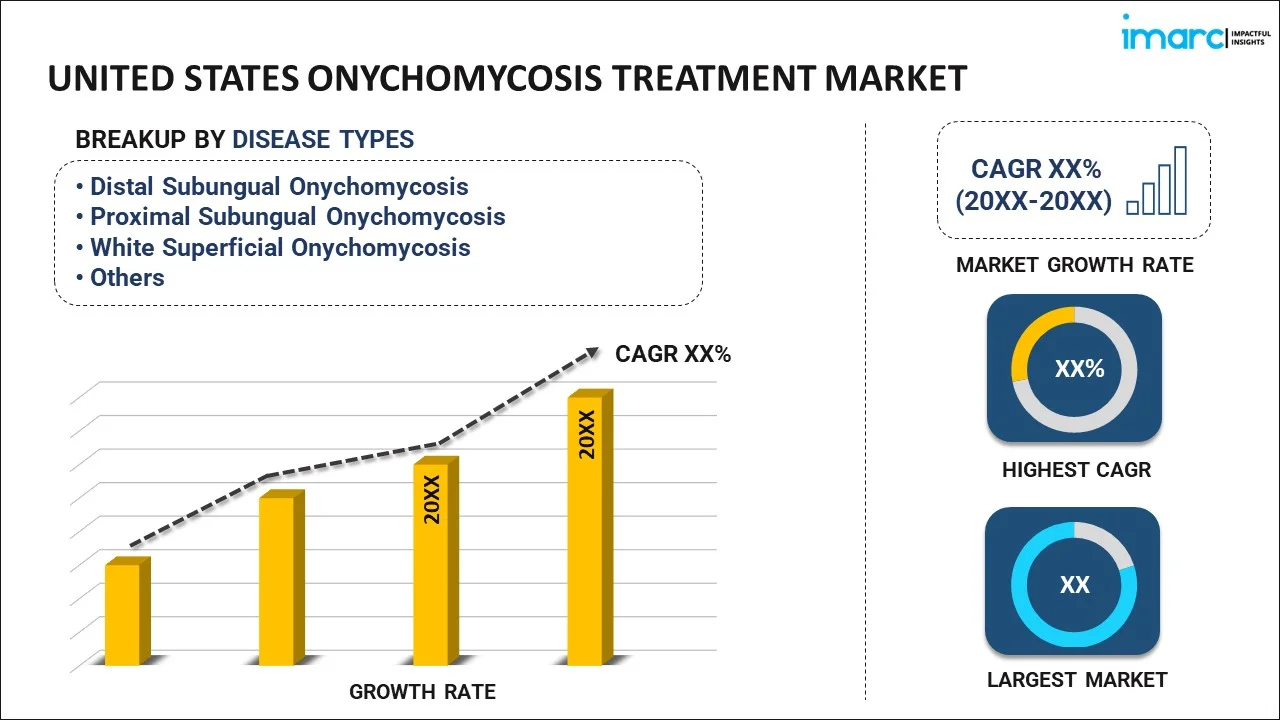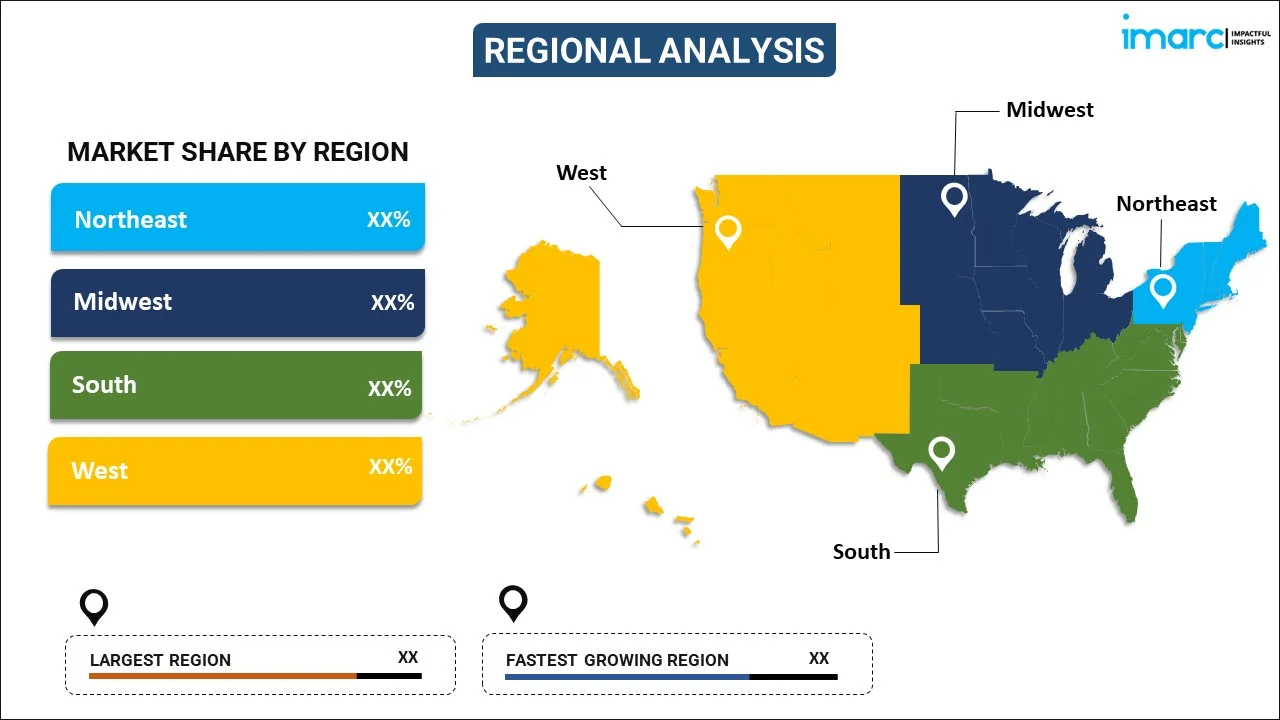
United States Onychomycosis Treatment Market Report by Disease Type (Distal Subungual Onychomycosis, Proximal Subungual Onychomycosis, White Superficial Onychomycosis, Candidal Onychomycosis, and Others), Treatment Type (Laser Therapy, Photodynamic Therapy, Drug Treatment), Drug Class (Allylamine, Azole, Griseofulvin, and Others), Distribution Channel (Hospitals and Clinics, Online Stores, Retail Pharmacies, and Others), and Region 2025-2033
Market Overview:
United States onychomycosis treatment market size reached USD 552 Million in 2024. Looking forward, IMARC Group expects the market to reach USD 865.2 Million by 2033, exhibiting a growth rate (CAGR) of 5.11% during 2025-2033. The increasing innovations in diagnostic tools and technologies for onychomycosis that can enhance the accuracy of diagnosis, leading to better-targeted treatments, are driving the market.
|
Report Attribute
|
Key Statistics
|
|---|---|
|
Base Year
|
2024
|
|
Forecast Years
|
2025-2033
|
|
Historical Years
|
2019-2024
|
|
Market Size in 2024
|
USD 552 Million |
|
Market Forecast in 2033
|
USD 865.2 Million |
| Market Growth Rate 2025-2033 | 5.11% |
Onychomycosis, commonly known as toenail fungus, is a persistent and challenging condition that affects a significant portion of the population. The treatment of onychomycosis is multifaceted, encompassing both topical and systemic approaches. Topical antifungal agents, such as creams and nail lacquers, are frequently employed for milder cases. These formulations typically contain ingredients like amorolfine or ciclopirox, aiming to inhibit the growth of the fungus. However, they may require prolonged and consistent application to achieve desired results. In more severe or resistant cases, oral antifungal medications become the primary course of action. Drugs like terbinafine and itraconazole are commonly prescribed, penetrating the bloodstream to target the infection systemically. While oral medications offer higher success rates, they may come with potential side effects and require close monitoring by healthcare professionals. Additionally, innovative treatments, such as laser therapy, have emerged in recent years, showing promise in selectively targeting the fungus without causing harm to surrounding tissues.
United States Onychomycosis Treatment Market Trends:
The onychomycosis market in the United States has propelled the growth of the treatment market, with several key drivers steering its expansion. Firstly, the rising incidence of onychomycosis has stimulated increased demand for effective treatment options. Moreover, the aging population, particularly susceptible to this condition, contributes significantly to market growth. Additionally, advancements in medical research and technology have led to the development of innovative treatment modalities, fostering market expansion. Furthermore, the increasing awareness and understanding of onychomycosis among both healthcare professionals and the general population have driven early diagnosis and treatment initiation, positively impacting market dynamics. The growing emphasis on personal grooming and aesthetic concerns has further heightened the demand for onychomycosis treatments. Collaborative efforts between pharmaceutical companies and healthcare organizations to enhance treatment accessibility and affordability also play a pivotal role in driving market progression. Overall, a confluence of demographic trends, technological advancements, and heightened awareness collectively propels the onychomycosis treatment market forward in the United States.
United States Onychomycosis Treatment Market Segmentation:
IMARC Group provides an analysis of the key trends in each segment of the market, along with forecasts at the country level for 2025-2033. Our report has categorized the market based on disease type, treatment type, drug class, and distribution channel.
Disease Type Insights:

- Distal Subungual Onychomycosis
- Proximal Subungual Onychomycosis
- White Superficial Onychomycosis
- Candidal Onychomycosis
- Others
The report has provided a detailed breakup and analysis of the market based on the disease type. This includes distal subungual onychomycosis, proximal subungual onychomycosis, white superficial onychomycosis, candidal onychomycosis, and others.
Treatment Type Insights:
- Laser Therapy
- Photodynamic Therapy
- Drug Treatment
A detailed breakup and analysis of the market based on treatment type have also been provided in the report. This includes laser therapy, photodynamic therapy, and drug treatment.
Drug Class Insights:
- Allylamine
- Azole
- Griseofulvin
- Others
The report has provided a detailed breakup and analysis of the market based on the drug class. This includes allylamine, azole, griseofulvin, and others.
Distribution Channel Insights:
- Hospitals and Clinics
- Online Stores
- Retail Pharmacies
- Others
A detailed breakup and analysis of the market based on distribution channel have also been provided in the report. This includes hospitals and clinics, online stores, retail pharmacies, and others.
Regional Insights:

- Northeast
- Midwest
- South
- West
The report has also provided a comprehensive analysis of all the major regional markets, which include the Northeast, Midwest, South, and West.
Competitive Landscape:
The market research report has also provided a comprehensive analysis of the competitive landscape in the market. Competitive analysis such as market structure, key player positioning, top winning strategies, competitive dashboard, and company evaluation quadrant has been covered in the report. Also, detailed profiles of all major companies have been provided.
United States Onychomycosis Treatment Market Report Coverage:
| Report Features | Details |
|---|---|
| Base Year of the Analysis | 2024 |
| Historical Period | 2019-2024 |
| Forecast Period | 2025-2033 |
| Units | Million USD |
| Scope of the Report | Exploration of Historical Trends and Market Outlook, Industry Catalysts and Challenges, Segment-Wise Historical and Future Market Assessment:
|
| Disease Types Covered | Distal Subungual Onychomycosis, Proximal Subungual Onychomycosis, White Superficial Onychomycosis, Candidal Onychomycosis, Others |
| Treatment Types Covered | Laser Therapy, Photodynamic Therapy, Drug Treatment |
| Drug Classes Covered | Allylamine, Azole, Griseofulvin, Others |
| Distribution Channels Covered | Hospitals and Clinics, Online Stores, Retail Pharmacies, Others |
| Regions Covered | Northeast, Midwest, South, West |
| Customization Scope | 10% Free Customization |
| Post-Sale Analyst Support | 10-12 Weeks |
| Delivery Format | PDF and Excel through Email (We can also provide the editable version of the report in PPT/Word format on special request) |
Key Questions Answered in This Report:
- How has the United States onychomycosis treatment market performed so far and how will it perform in the coming years?
- What has been the impact of COVID-19 on the United States onychomycosis treatment market?
- What is the breakup of the United States onychomycosis treatment market on the basis of disease type?
- What is the breakup of the United States onychomycosis treatment market on the basis of treatment type?
- What is the breakup of the United States onychomycosis treatment market on the basis of drug class?
- What is the breakup of the United States onychomycosis treatment market on the basis of distribution channel?
- What are the various stages in the value chain of the United States onychomycosis treatment market?
- What are the key driving factors and challenges in the United States onychomycosis treatment?
- What is the structure of the United States onychomycosis treatment market and who are the key players?
- What is the degree of competition in the United States onychomycosis treatment market?
Key Benefits for Stakeholders:
- IMARC’s industry report offers a comprehensive quantitative analysis of various market segments, historical and current market trends, market forecasts, and dynamics of the United States onychomycosis treatment market from 2019-2033.
- The research report provides the latest information on the market drivers, challenges, and opportunities in the United States onychomycosis treatment market.
- Porter's five forces analysis assist stakeholders in assessing the impact of new entrants, competitive rivalry, supplier power, buyer power, and the threat of substitution. It helps stakeholders to analyze the level of competition within the United States onychomycosis treatment industry and its attractiveness.
- Competitive landscape allows stakeholders to understand their competitive environment and provides an insight into the current positions of key players in the market.
Need more help?
- Speak to our experienced analysts for insights on the current market scenarios.
- Include additional segments and countries to customize the report as per your requirement.
- Gain an unparalleled competitive advantage in your domain by understanding how to utilize the report and positively impacting your operations and revenue.
- For further assistance, please connect with our analysts.
 Inquire Before Buying
Inquire Before Buying
 Speak to an Analyst
Speak to an Analyst
 Request Brochure
Request Brochure
 Request Customization
Request Customization




.webp)




.webp)












